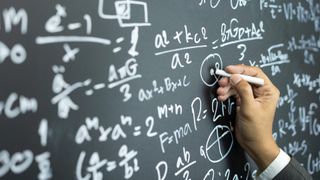What is a scientific theory?
A scientific theory is based on careful examination of facts.

A scientific theory is a structured explanation to explain a group of facts or phenomena in the natural world that often incorporates a scientific hypothesis and scientific laws. The scientific definition of a theory contrasts with the definition most people use in casual language.
"The way that scientists use the word 'theory' is a little different than how it is commonly used in the lay public," said Jaime Tanner, a professor of biology at Emerson College in Boston. "Most people use the word 'theory' to mean an idea or hunch that someone has, but in science the word 'theory' refers to the way that we interpret facts."
Related: 5 sci-fi concepts that are possible (in theory)
The process of becoming a scientific theory
Every scientific theory relies on the scientific method. A scientist may make an observation and devise a hypothesis to explain that observation, then design an experiment to test that hypothesis. If the hypothesis is shown to be incorrect, the scientist will develop a new hypothesis and begin the process again. If the hypothesis is supported by the results of the experiment, it will go on to be tested again. If the hypothesis isn't disproven or surpassed by a better explanation, the scientist may incorporate it into a larger theory that helps to explain the observed phenomenon and relates it to other phenomena, according to the Field Museum.
A scientific theory is not the end result of the scientific method; theories can be proven or rejected, just like hypotheses. And theories are continually improved or modified as more information is gathered, so that the accuracy of the prediction becomes greater over time.
Theories are foundations for furthering scientific knowledge and for putting the information gathered to practical use. Scientists use theories to develop inventions or find a cure for a disease.
Furthermore, a scientific theory is the framework for observations and facts, Tanner said. Theories may change, or the way that they are interpreted may change, but the facts themselves don't change. Tanner likens theories to a basket in which scientists keep facts and observations that they find. The shape of that basket may change as the scientists learn more and include more facts. "For example, we have ample evidence of traits in populations becoming more or less common over time (evolution), so evolution is a fact, but the overarching theories about evolution, the way that we think all of the facts go together might change as new observations of evolution are made," Tanner told Live Science.
Characteristics of a good theory
The University of California, Berkeley, defines a theory as "a broad, natural explanation for a wide range of phenomena. Theories are concise, coherent, systematic, predictive, and broadly applicable, often integrating and generalizing many hypotheses."
According to Columbia University emeritus professor of philosophy Philip Kitcher, a good scientific theory has three characteristics. First, it has unity, which means it consists of a limited number of problem-solving strategies that can be applied to a wide range of scientific circumstances. Second, a good scientific theory leads to new questions and new areas of research. This means that a theory doesn't need to explain everything in order to be useful. And finally, a good theory is formed from a number of hypotheses that can be tested independently from the theory itself.
The difference between theories, facts and laws
Any scientific theory must be based on a careful and rational examination of the facts. Facts and theories are two different things. In the scientific method, there is a clear distinction between facts, which can be observed and/or measured, and theories, which are scientists' explanations and interpretations of the facts.
Some think that theories become laws, but theories and laws have separate and distinct roles in the scientific method. A law is a description of an observed phenomenon in the natural world that holds true every time it is tested. It doesn't explain why something is true; it just states that it is true. A theory, on the other hand, explains observations that are gathered during the scientific process. So, while law and theory are part of the scientific process, they are two different aspects, according to the National Center for Science Education.
A good example of the difference between a theory and a law is the case of Gregor Mendel. In his research, Mendel discovered that two separate genetic traits would appear independently of each other in different offspring. "Yet, Mendel knew nothing of DNA or chromosomes. It wasn't until a century later that scientists discovered DNA and chromosomes — the biochemical explanation of Mendel's laws," said Peter Coppinger, an associate professor of biology and biomedical engineering at the Rose-Hulman Institute of Technology. "It was only then that scientists, such as T.H. Morgan working with fruit flies, explained the Law of Independent Assortment using the theory of chromosomal inheritance. Still today, this is the universally accepted explanation [theory] for Mendel's Law."
Additional resources
- When does a theory become a fact? This article from Arizona State University says you're asking the wrong question!
- Learn the difference between the casual and scientific uses of "theory" and "law" from the cartoony stars of the Amoeba Sisters on Youtube.
- Can a scientific theory be falsified? This article from Scientific American says no.
Bibliography
Kenneth Angielczyk, "What Do We Mean by "Theory" in Science?" Field Museum, March 10, 2017. https://www.fieldmuseum.org/blog/what-do-we-mean-theory-science
University of California, Berkeley, "Science at multiple levels." https://undsci.berkeley.edu/article/0_0_0/howscienceworks_19
Philip Kitcher, "Abusing Science: The Case Against Creationism," MIT Press, 1982.
National Center for Science Education, "Definitions of Fact, Theory, and Law in Scientific Work," March 16, 2016 https://ncse.ngo/definitions-fact-theory-and-law-scientific-work
Sign up for the Live Science daily newsletter now
Get the world’s most fascinating discoveries delivered straight to your inbox.

